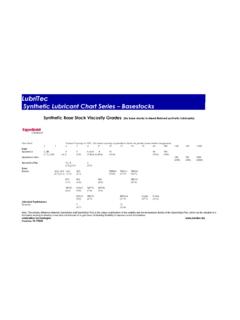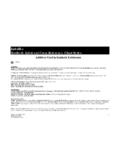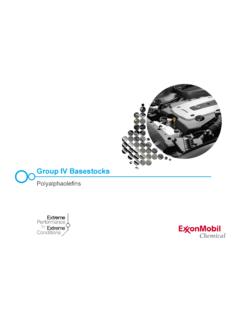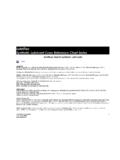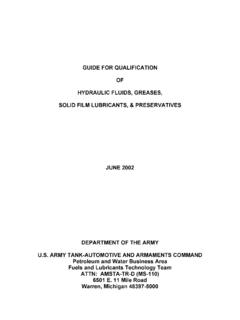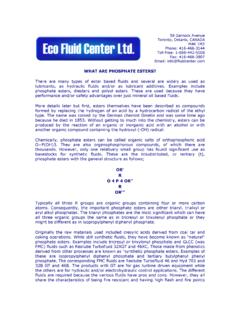Transcription of Industrial Food-Grade Lubricants Guide
1 Industrial Food-Grade Lubricants Guide [Type the company name]. White Paper Sponsored by: [Type the company address] Clarion Lubricants 1293 Eldridge Parkway [Type the phone number] Houston, TX 77077. [Pick the date]. Phone: 832-486-4375. Fax: 832-486-1865. Email: Industrial Food-Grade Lubricants Guide By Jim C. Fitch, Martin Williamson and Sabrin Gebarin, Noria Corporation 1. Introduction The food processing industry presents unique challenges to lubricant formulation engineers, lubricant marketers, plant lubrication engineers, equipment designers and builders. While it is never desirable for Lubricants to be allowed to contaminate raw materials, work-in-progress or finished product, the consequences of a lubricant-contaminated product is rarely more acute than in the food processing industry.
2 As such, Lubricants used in this industry have requirements, protocols and performance expectations that go well beyond typical Industrial Lubricants . This paper provides a general overview of the unique challenges associated with Food-Grade Lubricants , including recent revisions of the regulatory environment. The terminology commonly used by suppliers and clients of Food-Grade products will also be defined and discussed. So, too, will be machine applications common to certain sectors of the food processing industry and their unique requirements for Food-Grade Lubricants . 2. The Food Processing Industry Food-Grade Lubricants are significant in scope and application when you consider the size of the food processing industry.
3 In the United States, food manufacturers represent a significant percentage of total manufacturing. According to the 1997 United States Census, approximately $485 billion in sales revenue was generated (about the same amount generated in the transportation manufacturing industry). This represents almost 13 percent of all manufacturing in the In 1997, approximately 28,000 manufacturing facilities employed billion employees and produced 233 billion dollars in goods [1]. 3. Current Registration Practices Historically, the two government agencies primarily involved in food processing were the United States Department of Agriculture (USDA), which regulates meat, poultry and plants; and the Food and Drug Administration (FDA), which monitors other food and pharmaceutical manufacturing operations.
4 Regulations Prior to 1998. Prior to 1998, approval and compliance of Food-Grade Lubricants was the responsibility of the USDA. The Food Safety and Inspection Services (FSIS), headed by the USDA, reviewed the formulations of maintenance and operating chemicals. FSIS required meat and poultry facilities to use only non-food compounds that were pre-approved by the USDA authorization program. However, these programs spread to other food market sectors such as fisheries and retail food operations [2]. To gain USDA approval, lubricant manufacturers had to prove that all of the ingredients in the formulation were allowable substances.
5 Allowable substances, in this instance, are those listed by the FDA in accordance with the Guidelines of Security Code of Federal Regulations (CFR) Title 21, This did not include lubricant testing;. rather, the approval was based primarily on a review of the formulation ingredients of the lubricant [2]. Changes in Food-Grade Lubrication Standards After 1998. Starting in February 1998, the FSIS significantly altered its program by implementing a system established by Hazard Analysis and Critical Control Point (HACCP) requiring the manufacturer to assess risk at each point in the operation where contamination might occur. The National Aeronautics and Space Administration (NASA) originally developed the HACCP system in the 1960s to prevent astronauts from receiving any food-borne illnesses.
6 It established measures like minimum cooking temperatures for each control point and instituted procedures to monitor these measures and also provides corrective actions if critical limits are not met [3]. In essence, the manufacturer became responsible for reviewing and approving the chemical compositions of Lubricants to decide whether they were safe or not as Food-Grade Lubricants . 2. Third-Party Certifications In response to the change in the approval process, several commercial organizations developed external certification programs. Three such organizations were the National Sanitation Foundation (NSF), Underwriters Laboratory (UL) and a joint effort by three recognized industry professional associations: the National Lubricating Grease Institute (NLGI), the European Lubricating Grease Institute (ELGI) and the European Hygienic Equipment Design Group (EHEDG).
7 NSF has developed a lubricant evaluation program that essentially mirrors the FSIS program by evaluating the candidate lubricant formulations to verify compliance with the various FDA Code of Federal Regulations (CFR). Each component in the formulation is submitted to NSF by the lubricant manufacturer along with other supporting documentation. This is then reviewed to verify it is within the FDA list of permitted substances [4]. NSF's Web site provides food processing manufacturers with a continually updated list of approved Lubricants at (Figure 1). Figure 1. NSF's search engine of approved Lubricants in H1, H2 and H3 applications.
8 UL is another organization that began third-party certification of Food-Grade Lubricants but no longer is doing so. While they have not been as active as NSF in the area of Food-Grade Lubricants , in the past, UL organized several informational meetings, inviting lubricant and chemical manufacturers to attend [5]. The NLGI / ELGI/ EHEDG Joint Food-Grade Lubricants Working Group has been active in drafting an authorization program for Food-Grade Lubricants . This group's program is also based on the former USDA/FSIS authorization program and CFR policies. Its plan is to develop a DIN standard in Germany and use the DIN standard to later develop an ISO (International Organization for Standardization) standard [5].
9 Not all countries use third-party certifications. Canada, New Zealand, Australia and Japan are some of the countries that federally regulate Food-Grade Lubricants [1]. However the Canadian Food Inspection Agency (CFIA) is working on a Food-Grade Lubricants approval system, and NSF will help with the CFIA review process. Also, the Australian Quarantine Inspection Service has approved approximately 50 Food-Grade Lubricants based on NSF registration [6]. 3. 4. Challenges Facing Food-Grade Lubricants Agricultural and animal substances go through a number of processes in a manufacturing plant, such as cleansing, sterilizing, blending, mixing, cooking, freezing, cutting, packaging, canning or bottling.
10 Large-scale food processing requires machinery such as pumps, mixers, tanks, hoses and pipes, chain drives, and conveyor belts. Machinery used in food processing facilities face many of the same tribological and lubrication challenges found in other non-food processing plants. In that sense, Lubricants must offer similar protection of internal surfaces to control friction, wear, corrosion, heat and deposits. They must also offer good pumpability, oxidation stability, hydrolytic stability and thermal stability where the application so requires. Many of the raw materials used to formulate Lubricants that effectively address these challenges in conventional Industrial applications are not permissible in food applications for safety reasons.


